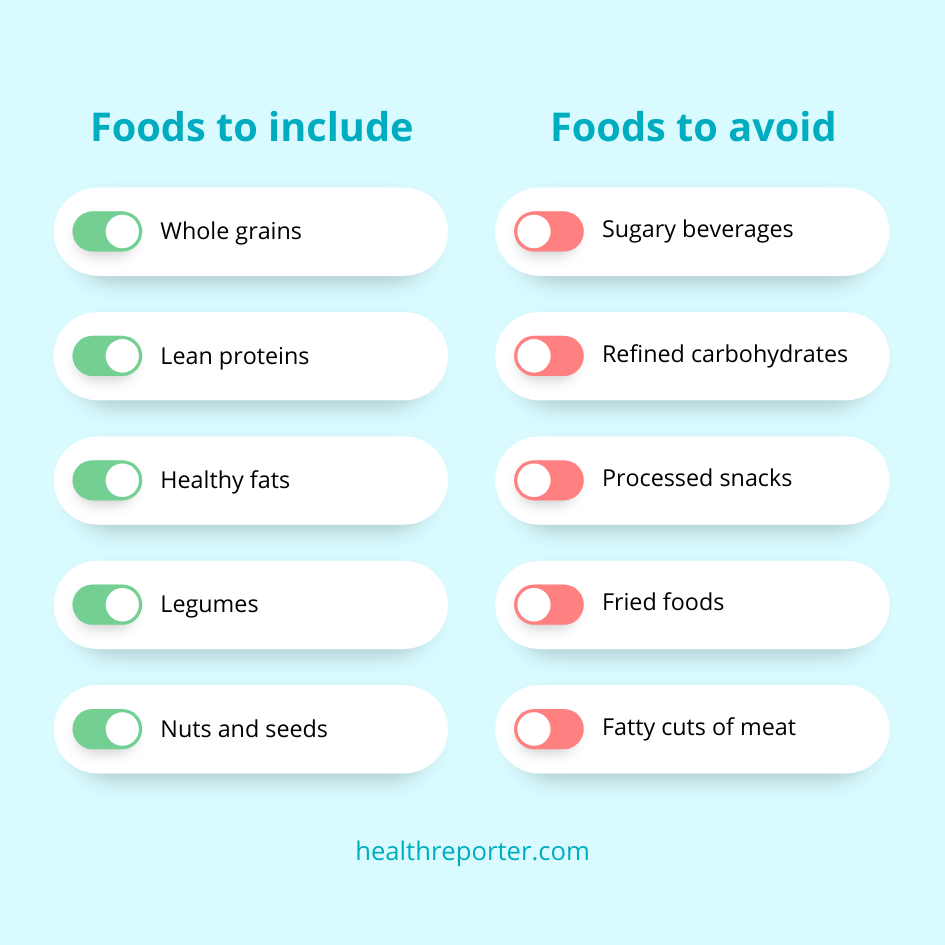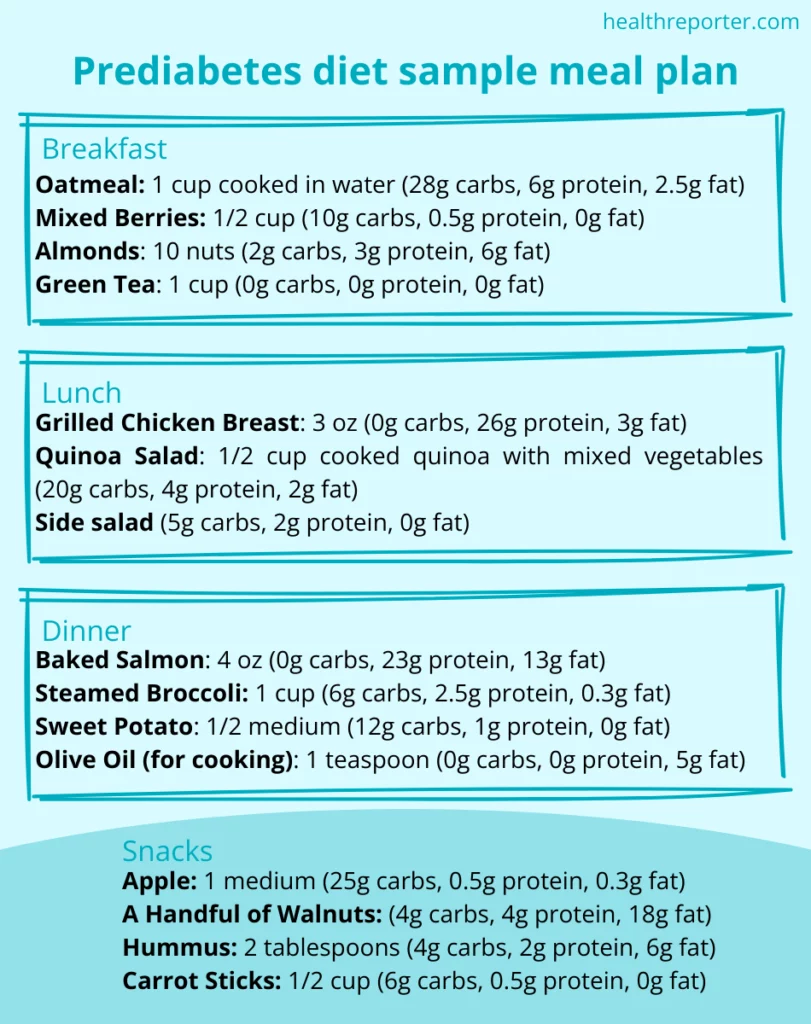Prediabetes Diet: Transform Your Health With This Ultimate Guide
The prediabetes puzzle: solving it with savvy food choices

Prediabetes is the limbo between health and a debilitating chronic disease that requires lifelong treatment.
This intermediate state is a warning that gives you the opportunity to correct your lifestyle to prevent its progression to type 2 diabetes.
It is important to recognize the personal, genetic and nutritional risk factors you have in order to get routine checkups on time.
Read on to understand this diagnosis in depth and learn about the prediabetes diet as the main tool to reverse it and improve your health.
Understanding Prediabetes
Prediabetes is a condition in which blood glucose levels show elevated numbers on routine test findings. These blood sugar levels may go unnoticed because they are not high enough to cause symptoms.
In some cases, mild diabetes-like symptoms may appear, which are frequent urination, delayed wound healing, increased thirst, and blurred vision. All these symptoms are associated with high blood sugar levels.
The normal blood sugar level is between 70 – 100 mg/dl, while the diagnosis of type 2 diabetes is made when you have had more than 126 mg/dl on more than 3 separate occasions. A prediabetes fasting blood sugar level is 100 to 125 mg/dL (5.6 to 6.9 mmol/L).
People with risk factors such as obesity, sedentary lifestyle, poor eating habits, high blood pressure, and high cholesterol are recommended to have regular check-ups to rule out prediabetes, which can be reversed at this stage.
In addition, women who previously had gestational diabetes should continue to monitor their glucose after childbirth as they are at risk of developing prediabetes or type 2 diabetes in the future.
In case of finding suspiciously high blood sugar levels, but not high enough to be considered a risk of developing type 2 diabetes, it will be necessary to implement a prediabetes diet as a measure to stop the progression of this disease.


“To manage prediabetes effectively, dietary adjustments should be personalized.
For older adults, a diet low in calories but high in nutrients like fiber, protein, and vitamins is ideal. Different nutritional needs for men and women must also be considered; women may need more calcium and iron, while men might benefit from more protein.
Thus, a gender-specific approach could include more dairy for women and lean meat for men.”
Key Components of a Prediabetes Diet
A prediabetes diet can be simplified by following a few simple rules. Maintaining balanced blood sugar levels and prioritizing your overall health is the main goal.
#1 Focus on low glycemix index foods
The main objective in the prediabetes diet is to prioritize the consumption of foods with a low glycemic index, which allows a slower and more controlled absorption of carbohydrates.
The glycemic index indicates, through a number, the capacity of a food to raise blood sugar. A lower number refers to a lower glycemic index.
Some foods with low glycemic index are legumes, whole grains and non-starchy vegetables, which contain a good amount of fiber, a fundamental element in the prediabetes diet.
#2 Include high fiber foods
Fiber is crucial for slowing down sugar absorption into the body. Prediabetes management relies heavily on maintaining stable blood glucose levels through slow absorption. Keeping your blood sugar stable also reduces the strain on your pancreas, which is vital for long-term health.
The fiber also is one of the main components of appetite suppressant supplements that are widely used to control cravings and suppress appetite.
#3 Eat a variety of lean protein sources
It is also important to focus on a good macronutrient balance by choosing healthy proteins that promote satiety and control cravings.
As lean proteins do not significantly affect blood sugar levels, they are ideal for managing prediabetes. They provide essential nutrients without spiking blood glucose levels like carbohydrates.
Compared to carbohydrates or fats, proteins are more satisfying, which allows you to feel full longer. When managing your prediabetes, controlling your overall calorie intake is crucial, especially if you are trying to lose weight.
#4 Incorporate sources of unsaturated fats
Foods such as avocados, nuts, seeds, and olive oil contain unsaturated fats that are beneficial for heart health. Prediabetes patients are at greater risk of heart disease, and this is particularly relevant to them. The fats in these foods reduce bad cholesterol levels and promote good cholesterol, resulting in a healthy cardiovascular system.
#5 Maintain balance
Micronutrients such as vitamins, antioxidants and minerals are essential to ensure overall good health and curb inflammation.
The key is to control portions and seek professional help to obtain a personalized nutritional plan for prediabetes since carbohydrate requirements vary according to different factors such as age, physical activity and body weight.
Foods to Include in Prediabetes Diet
A prediabetes diet should emphasize foods that promote overall health and help manage blood sugar levels. Here’s a list of foods to include:
#1 Whole Grains: whole grain bread, brown rice, quinoa, oatmeal, and whole wheat pasta. These have more fiber and nutrients compared to their refined counterparts.
#2 Lean Proteins: skinless poultry, fish, lean cuts of meat, tofu, tempeh, and eggs. These foods provide essential nutrients without excess fat.
#3 Healthy Fats: olive oil, avocados, nuts, seeds, and fatty fish like salmon and mackerel. These fats are heart-healthy and don’t impact blood sugar levels significantly.
#4 Legumes: Beans, lentils, and chickpeas are great sources of fiber and protein, making them excellent for blood sugar control.
#5 Non-Starchy Vegetables: leafy greens, bell peppers, broccoli, cauliflower, and zucchini. They are low in calories and carbs but high in vitamins, minerals, and fiber.
#6 Low Glycemic Fruits: Berries, apples, pears, and oranges are preferable as they have a lower impact on blood sugar levels.
#7 Dairy or Dairy Alternatives: low-fat or fat-free dairy and non-dairy options.
#8 Nuts and Seeds: almonds, walnuts, flaxseeds, and chia seeds.
#9 Water and Herbal Teas: stay hydrated with water, herbal teas, or other non-caloric beverages to help manage blood sugar levels.

Carbohydrates: Subgroups and Daily Servings for Prediabetes Diet
Controlling carbohydrates can be tedious, especially because you have to know how much each food contains to meet your requirement. To make this easier always check product labels to read how many grams of carbohydrates are in the product.
For unlabeled foods such as tubers or fruits, you can consult some of the best nutrition apps or official websites that contain nutritional data.
For healthy people, the American Diabetes Association had previously recommended keeping carbohydrates between 45-65% of total calories. For people with prediabetes, these amounts may be too high.
Currently, it is recommended to seek professional advice to establish what is the ideal amount of carbohydrates for each person with prediabetes.
Also, it is important to know the different types of carbohydrates to know which ones to include or avoid:
Starchy complex carbohydrates
These are unprocessed carbohydrates that are digested slowly and are dense in nutrients and fiber. Eat moderate amounts of potato, sweet potato, brown rice, quinoa and whole wheat bread.
Non-starchy complex carbohydrates
Contain fewer carbohydrates per serving and more fiber, promoting satiety, among which are leafy greens and vegetables such as broccoli, spinach, chard, peppers, zucchini, onions, among others, to increase the intake of fiber, vitamins and promote satiety.
Simple carbohydrates
These are carbohydrates that are digested very quickly, raising blood sugar levels, which is why they should be avoided. This group includes sugar, sugary drinks, refined flours, white bread, processed food and pastries.
Foods to Avoid or Limit in Prediabetes Diet
Here is a list of foods that are generally recommended to avoid or limit in a prediabetes diet:
#1 Sugary beverages: soda, sweetened coffee and tea, energy drinks, and fruit juices with added sugars.
#2 Refined carbohydrates: white bread, white rice, pastries, and other foods made with white flour.
#3 Processed snacks: chips, cookies, cakes, and other packaged snacks, which often contain refined carbs and added sugars.
#4 High-sugar fruits: bananas, pineapples, and grapes can be high in sugar and should be consumed in moderation.
#5 Fatty cuts of meat: reducing intake of fatty meats can help manage weight and cholesterol levels.
#6 Full-fat dairy products: limiting full-fat milk, cheese, and cream can aid in weight management.
#7 Fried foods: french fries, fried chicken, and other deep-fried items are high in unhealthy fats and calories.
#8 Alcohol: sugary mixed drinks, beer, and other high-carbohydrate alcoholic beverages.
#9 Artificial sweeteners: while they don’t raise blood sugar levels, they may affect your appetite and cravings for sweet foods.
#10 High-sodium foods: Excess salt can contribute to high blood pressure, a common issue in people with prediabetes.
When it comes to healthy eating for blood glucose control, there are two concepts to take into account: the glycemic index and the glycemic load.
Foods with a high glycemic index between 70 and 100 cause a very rapid increase in glucose which leads to hyperglycemia, and foods with a glycemic index lower than 55 are absorbed more slowly. A medium glycemic index is between 56 and 69. Some foods with high glycemic index are potatoes, white bread and commercial cereals.
The abrupt increase in blood sugars stimulates insulin secretion, which ends up causing insulin resistance when you eat high glycemic index products constantly, such as processed foods, refined flours and sugar.
On the other hand, your glucose control cannot depend only on the glycemic index since it only refers to the speed at which each food can raise your blood sugar.
You must consider glycemic load as it refers to the amount of carbohydrates each food contains.
The glycemic load value is interpreted with the following guidelines:
- Low glycemic load: 10 or less
- Medium glycemic load: Between 11 and 19
- High glycemic load: Greater than 20
For example, according to the University of Sydney database, boiled and mashed carrots have a glycemic index of 60, which corresponds to a medium GI, but have a low glycemic load of 6. This makes carrots a safe food for people with prediabetes.
Fats management for weight loss
A key aspect of managing prediabetes is to adhere to a diet that helps you control your blood sugar and also allows you to lose weight. A study have shown a direct relationship between weight loss and improved insulin resistance.
Counting calories is important to promote a healthy weight and fat is the macronutrient that contributes the most calories, adding 9 calories for every gram of fat.
While a healthy diet should prioritize healthy fats, these should be consumed in moderation and trans fats and saturated fats should be minimized or completely avoided.
To reduce the latter, choose lean meats that have no visible fat and opt for cooking methods that do not require the use of refined oils, such as boiling, grilling, and steaming.
Sample Meal Plan for Prediabetes Diet
Prediabetes is an opportunity to correct certain habits to avoid progressing to a more complicated disease like diabetes.
A proper diet will be the most important tool to achieve this. We know that trying to address every nutritional factor is complicated and therefore we have created a sample meal plan for prediabetes that you can use to start implementing the necessary changes.

Don’t forget that portion sizes and food choices should be adjusted based on individual calorie needs, activity levels, and blood sugar responses.
It’s best to consult a dietitian or a healthcare professional for a personalized meal plan, especially to adjust for specific carbohydrate, protein, and fat requirements.
Lifestyle Changes to Complement Prediabetes Diet
Lifestyle change is a commitment that must be embraced to achieve health transformation. You must recognize the negative habits that got you to this point in order to work on regaining your wellness.
Habits such as smoking and not drinking enough water can worsen this condition. Thirst during prediabetes is a warning sign as it may indicate elevated blood glucose.
When blood sugar is high, the kidney begins to filter it with a consequent increase in urination due to osmotic diuresis. This increased urination can cause dehydration and electrolyte imbalance, so it is essential to drink enough water during the day.
If you are a sedentary person because you find it hard to exercise or you think you don’t have enough time, find a way to move in your day-to-day life so you can burn some calories.
The Physical Activity Guidelines for Americans indicate that you should do at least 150 minutes of exercise in a week, which you can achieve by adding some walking and complementing it with other activities such as:
- Choosing the stairs instead of the elevator
- Parking your car farther away to walk a longer distance
- If you work in an office, take active breaks and try to complete a simple exercise routine
- Join a class where you can do aerobic exercise, yoga or dance
These activities will not only increase your chance of losing weight but will help you manage the stress of the day’s routine and will favor a restful sleep.
Stress is a key factor in managing chronic inflammation and keeping blood sugar levels under control. There is a clear relationship of cortisol and adrenaline to increased glucose availability, hormones released in times of stress.
In normal situations, the release of these hormones is useful because it ensures that you have the energy to cope with the stressful situation. When stress is prolonged, there may be an increased risk of developing prediabetes.
How to Monitor and Adjust Prediabetes Diet
Being attentive to warning signs such as increased urination or being very thirsty will not be enough to have good blood sugar control.
It is necessary to have a glucometer at hand to record glucose values. Talk to your doctor about this to find out how many times a day you should check your blood sugar.
Be sure to write down the results and the meals of the day so that you can easily recognize the foods that cause your blood sugar to rise.
If during the diet you feel some symptoms such as dizziness, nausea, headache or any other discomfort, consult your nutritionist to make the necessary adjustments to the diet.
Drastically reducing carbohydrates can cause these symptoms and you may feel discomfort at first.
A Word From Our MD


Receiving a diagnosis of prediabetes is often worrisome and creates a lot of uncertainty especially if you have other conditions such as obesity and cardiovascular disease which puts you at risk of developing type 2 diabetes.
The amount of dietary adjustments that must be made can sound overwhelming. While it is true that you must act immediately to stop the progression of this condition, you don’t need to make all the changes overnight.
By curbing excess junk food and sugary drinks including sweet tea and sweetened coffee drinks, you will avoid frequent glucose spikes.
Add better-quality foods like whole grains and high-fiber foods to your diet to promote a better insulin response.
Start cooking more at home and work in your relationship with food. Healthy eating and being totally aware of what you eat will help you control portions better and also help you enjoy your food.
FAQ
If prediabetes is detected early and lifestyle changes are made, it can often be reversed, and these changes can also improve blood pressure and cholesterol levels.
Prioritize the consumption of whole foods high in fiber, such as vegetables, seeds, and fruits, as they are absorbed slowly and avoid glucose spikes. Also, avoid processed and sugary products as they produce a sudden increase in blood sugar.
Despite the fact that fasting might be beneficial to some people with prediabetes, it is not universally recommended, especially for individuals with other health conditions.
Final Thoughts: Turning the Tide Against Prediabetes
With the right lifestyle changes and medical guidance, prediabetes can be effectively managed, providing an opportunity to improve your overall health and well-being.
Adjustments of routines and lifestyle habits are essential to avoid the progression of this condition to type 2 diabetes.
The primary approach to stopping prediabetes is to improve insulin sensitivity to manage blood sugars appropriately. This is accomplished with low glycemic index foods such as complex carbohydrates, high-fiber vegetables, and whole grains.

















































 Select your language:
Select your language: 







